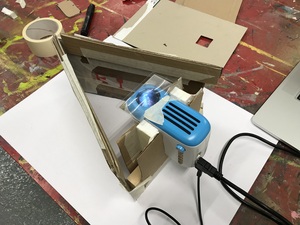Work for the 2019 NCAD evening school exhibition.
Themes
Seperation/Wholeness (Holograph)
Holography as an instrument of wholeness, grief as a kind of separation. To be in a state of grief is to be removed, but holographically complete. What is the process of restoration? It is a matter of fidelity, resolution and clarity. The larger the whole, the richer the wholeness.
This I find very interesting, as it resonates with my experience. While suffering you are still outwardly complete and perhaps even inwardly as well, but clearly there is a deficit at work, what is it which you lack in this case?
- A holograph defies framing
- You can not erect a single stable frame for all perceptions
- And the idea of synecdoche follows here as well
- On a personal level, you are the part which represents the whole
- That recognition, inwards and outwards, in a solipsistic way
Parents
- The continuation of the self from other selves
- Emotional history of others encoded in your own maladies
- The epigenesis of grief
- Grief thats larger than one lifetime
- That's harder to see let alone confront
Destruction
- Separation of things is required for analysis of them
- You must kill a thing to analyse it
- Life is always observed in wholeness
- In this way it defies analysis
- The absence of separation is connection with the whole, awareness, spirituality
- Who wants to be responsible for reconstructing an entire universe from the bottom up?
Memory/Time
- Imagery as the primary modality
- But imagination is the bigger part vs. recollection
- Higher-kinded memories, memories of memories
- Stories you reinforce
- Volatility and preservation of preferred experience
- Do not remember too often or too vigorously, or you will taint them
- Time
- Rendering higher dimensions into lower ones
- Multiplicity
- Rendering lower dimensions into higher ones
Work
Photographic experiments exploring the conceptual holograph, grief, memory.
Then, considering higher dimensional events projected to lesser dimensions - expanded three dimensional space and unbounded time on a finite two dimensional area with looped time.
I started with a miniature projector which was to be encapsulated in a box, making the smallest possible screen the only field. To achieve this, a reducing lens was used to adjust the focal length down to a few inches.
This leads to the projector itself, no longer a hidden mechanism, but rather a bound counterweight to the screen. The psychogeographical film loops on the screen continuously.
The exhibition setup. The projector was battery powered, but after the first weekend, I was compelled to use a mains power supply to keep the loop running continuously.











